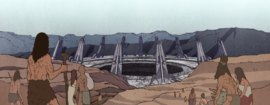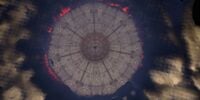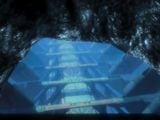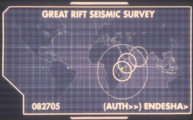Portal at Voi: Difference between revisions
From Halopedia, the Halo wiki
No edit summary |
|||
| Line 2: | Line 2: | ||
{{Megastructure infobox | {{Megastructure infobox | ||
|image=[[File:Ark portal open.jpg|300px]] | |image=[[File:Ark portal open.jpg|300px]] | ||
|description=Disc with seven pairs of rising | |description=Disc with seven pairs of rising petals | ||
|location=[[Kenya]], [[East African Protectorate]], [[Earth]] | |location=[[Kenya]], [[East African Protectorate]], [[Earth]] | ||
|type=[[Slipspace portal]] generator | |type=[[Slipspace portal]] generator | ||
| Line 17: | Line 17: | ||
=== Ancient history === | === Ancient history === | ||
{{Quote|Who will use this portal? Who will live to return here? And what will they think of this machine that I’ve buried? Those I have fought for, for so long. Those who, it is clear to me now, ultimately will and must inherit the Mantle. I can only hope that they will survive and upon returning, that they will find this portal and use it to travel to the Ark—in order that they might discover their rightful place in this galaxy, and the great responsibility they have finally inherited. They are the last of my children. They must reclaim their birthright.|The [[Librarian]] thinks on the future of the portal and its use by humanity.}} | {{Quote|Who will use this portal? Who will live to return here? And what will they think of this machine that I’ve buried? Those I have fought for, for so long. Those who, it is clear to me now, ultimately will and must inherit the Mantle. I can only hope that they will survive and upon returning, that they will find this portal and use it to travel to the Ark—in order that they might discover their rightful place in this galaxy, and the great responsibility they have finally inherited. They are the last of my children. They must reclaim their birthright.|The [[Librarian]] thinks on the future of the portal and its use by humanity.}} | ||
[[File:ObservingArtifact.png|Ancient humans observe the portal at some point following their species' reintroduction to Earth.| | [[File:ObservingArtifact.png|Ancient humans observe the portal at some point following their species' reintroduction to Earth.|270px|thumb|left]] | ||
Shortly before the firing of the [[Halo Array]], the [[Forerunner]] known as the [[Librarian]] ordered the construction of the portal beneath a savannah in what would later become [[Kenya]]. The Librarian knew that the portal would not be completed before the Halos were fired, and thus construction would continue for at least a century after [[Earth]] was [[Conservation Measure|reseeded]]. She had it built with the hope that humanity would one day use it to reap the benefits of the legacy the Forerunners left on the [[Installation 00|lesser Ark]]. A [[Gargantua-class transport]] sent by [[343 Guilty Spark]] at her request, along with the necessary components mined from the Earth, was used to build the portal.<ref>'''Halo: Silentium''', ''String 37''</ref> At least two varieties of [[sentinel]]s, [[Retriever]]s and [[Assembler Sentinel|Assembler]]s, were deployed from the transport and were also important to its construction. | Shortly before the firing of the [[Halo Array]], the [[Forerunner]] known as the [[Librarian]] ordered the construction of the portal beneath a savannah in what would later become [[Kenya]]. The Librarian knew that the portal would not be completed before the Halos were fired, and thus construction would continue for at least a century after [[Earth]] was [[Conservation Measure|reseeded]]. She had it built with the hope that humanity would one day use it to reap the benefits of the legacy the Forerunners left on the [[Installation 00|lesser Ark]]. A [[Gargantua-class transport]] sent by [[343 Guilty Spark]] at her request, along with the necessary components mined from the Earth, was used to build the portal.<ref>'''Halo: Silentium''', ''String 37''</ref> At least two varieties of [[sentinel]]s, [[Retriever]]s and [[Assembler Sentinel|Assembler]]s, were deployed from the transport and were also important to its construction. | ||
When humans and other lifeforms were reintroduced to Earth, they emerged at the planet above the portal in Africa.<ref>'''[[Halo: Rebirth]]'''</ref> However, work on it would continue for multiple generations. Its continual construction was witnessed by humans, including an African elder named [[N'chala]], who was oblivious to its purpose and considered the sentinels to either be gods or to be under their direction.<ref name="cradle">'''[[Halo 3: The Cradle of Life]]'''</ref> While the artifact was always designed to be partially buried in the earth, it eventually came to be entirely buried through unknown means. | When humans and other lifeforms were reintroduced to Earth, they emerged at the planet above the portal in Africa.<ref>'''[[Halo: Rebirth]]'''</ref> However, work on it would continue for multiple generations. Its continual construction was witnessed by humans, including an African elder named [[N'chala]], who was oblivious to its purpose and considered the sentinels to either be gods or to be under their direction.<ref name="cradle">'''[[Halo 3: The Cradle of Life]]'''</ref> While the artifact was always designed to be partially buried in the earth, it eventually came to be entirely buried through unknown means. | ||
=== Discovery === | === Discovery === | ||
| Line 35: | Line 34: | ||
{{Quote|There are more secrets locked under our feet than we dare speculate on.|Doctor [[William Iqbal]] in a letter from the Department of Xenoarchaeological Studies at [[Edinburgh University]] to security-cleared faculty and onsite graduate students.<ref name="evo"/>}} | {{Quote|There are more secrets locked under our feet than we dare speculate on.|Doctor [[William Iqbal]] in a letter from the Department of Xenoarchaeological Studies at [[Edinburgh University]] to security-cleared faculty and onsite graduate students.<ref name="evo"/>}} | ||
[[File:PortalOrbit.png|thumb|left|250px|The portal as seen from orbit immediately after it collapsed following damage done to the Ark.]] | [[File:PortalOrbit.png|thumb|left|250px|The portal as seen from orbit immediately after it collapsed following damage done to the Ark.]] | ||
When [[Installation 04B]] was prematurely fired on December 11, 2552, it tore itself to pieces, doing an enormous amount of damage to the Ark. This sudden destruction caused the portal to collapse while the ''Forward Unto Dawn'' was still traveling through it back to Earth. The ship was torn in to two large pieces at this time and only the fore half made it back to Earth, crashing into the Indian Ocean. From that point onward, the portal remained inert and inaccessible. In [[2553]], civilian [[Xenoarchaeology|xenoarchaeologists]] were hired by the [[Office of Naval Intelligence]] to study the artifact. While closed, it was still drawing power from an unknown source and the majority of the passageways below it were still unexplored.<ref name="evo"/>It was suspected that the portal had additional as-of-yet undiscovered functions besides simply creating a gateway between Earth and the Ark.<ref name="evo"/> | When [[Installation 04B]] was prematurely fired on December 11, 2552, it tore itself to pieces, doing an enormous amount of damage to the Ark. This sudden destruction caused the portal to collapse while the ''Forward Unto Dawn'' was still traveling through it back to Earth. The ship was torn in to two large pieces at this time and only the fore half made it back to Earth, crashing into the Indian Ocean. The *Dawn* did not exit at the point in Earth's atmosphere where it would have had the portal remained wholly intact, but instead emerged from [[slipspace]] in Earth's orbit, just narrowly allowing [[Thel 'Vadam]] a destination to land. From that point onward, the portal remained inert and inaccessible. In [[2553]], civilian [[Xenoarchaeology|xenoarchaeologists]] were hired by the [[Office of Naval Intelligence]] to study the artifact. While closed, it was still drawing power from an unknown source and the majority of the passageways below it were still unexplored.<ref name="evo"/>It was suspected that the portal had additional as-of-yet undiscovered functions besides simply creating a gateway between Earth and the Ark.<ref name="evo"/> | ||
In [[2555]], scientists exploring [[Installation 07]] discovered a countdown sequence and it was determined that it was originating from the Ark. It suddenly became pf paramount importance that the portal be reactivated. The UNSC reached out to the [[Swords of Sanghelios]] and a Huragok named [[Drifts Randomly]] that had worked onboard the [[Forerunner Dreadnaught]] was brought to Earth. After a few days, it was able to open the portal using data from the keyship it had internalized. A joint UNSC and Swords of Sanghelios team was sent through the portal to [[Operation: FAR STORM|prevent]] the activation of the [[Halo Array]]. The countdown was part of a ploy by the Ark's monitor, [[000 Tragic Solitude]], to make the humans on Earth reactivate the portal so that he could send [[Retriever Sentinel]]s to mine the [[Sol system]] for materials to repair damage done to his installation. Many Retrievers poured through the portal and the [[UNSC Home Fleet]] engaged them in battle. Operation: FAR STORM successfully prevented Solitude's plan from coming to fruition, however, and the sentinels were recalled.<ref>'''[[Halo: Hunters in the Dark]]'''</ref>Afterwards, the UNSC used the now-active portal to send researchers to the Ark. | In [[2555]], scientists exploring [[Installation 07]] discovered a countdown sequence and it was determined that it was originating from the Ark. It suddenly became pf paramount importance that the portal be reactivated. The UNSC reached out to the [[Swords of Sanghelios]] and a Huragok named [[Drifts Randomly]] that had worked onboard the [[Forerunner Dreadnaught]] was brought to Earth. After a few days, it was able to open the portal using data from the keyship it had internalized. A joint UNSC and Swords of Sanghelios team was sent through the portal to [[Operation: FAR STORM|prevent]] the activation of the [[Halo Array]]. The countdown was part of a ploy by the Ark's monitor, [[000 Tragic Solitude]], to make the humans on Earth reactivate the portal so that he could send [[Retriever Sentinel]]s to mine the [[Sol system]] for materials to repair damage done to his installation. Many Retrievers poured through the portal and the [[UNSC Home Fleet]] engaged them in battle. Operation: FAR STORM successfully prevented Solitude's plan from coming to fruition, however, and the sentinels were recalled.<ref>'''[[Halo: Hunters in the Dark]]'''</ref>Afterwards, the UNSC used the now-active portal to send researchers to the Ark. | ||
== Trivia == | == Trivia == | ||
* | *Before ''[[Halo: The Essential Visual Guide]]'' established a definitive diameter for the portal, there was some confusion regarding its size. This was due to a conflict between the in-game sizes of the Forerunner Dreadnought in ''Halo 2'' and ''Halo 3'', with the latter depicting the ship as being far smaller than its former incarnation. Based on the map geometry in ''Halo 3'', the Portal could be estimated to be approximately 25 kilometers in diameter.<ref>[http://carnage.bungie.org/haloforum/halo.forum.pl?read=845588 '''halo.bungie.org''': ''Artifact Sizing *Minor H3 Spoilers*'']</ref> However, this figure is contradicted by the geography of the Portal's surroundings; since the structure stretches from the edge of where the metropolis of [[New Mombasa]] used to be all the way to the edge of what was formerly Voi, a distance of well over 100 kilometers. The canonical size of the portal can be derived by referencing the in-game measurements of the Forerunner Dreadnought as it appears in ''Halo 2''.<ref>'''[[Halo 2]]'''</ref><ref>'''[[Halo 3]]'''</ref><ref>'''[[Halo 3: ODST]]'''</ref><ref>[http://nikon.bungie.org/misc/sloftus_scalecomparison/?display=HighCharity '''Halo.bungie.org''': ''Determining the Real Sizes of Objects in Halo'']</ref> The sizes of the portal and the Dreadnaught in ''Halo 3'' were taken as a liberties resulting from to engine limitations; generating map geometry for over a 117 km<sup>2</sup> area would have been extremely taxing, if not impossible, for the game engine. | ||
*In the "Behind the Scenes" section of the ''Halo 2'' Collectors Edition, there is a sketch of the portal. | |||
*The | *The fourteen petals of the portal structure may be a reference to the number 7, as 7+7=14. The entire structure also appears to be constructed of seven identical parts, those being seven pairs of petals. The Portal is also 117 kilometers in diameter, which is a direct reference to[[ John-117]]. | ||
* | *Originally, the structure that ended up being the portal had been intended to be the Ark itself. Interestingly, the UNSC assumed the portal was the Ark as it neared activation in *Halo 3*. | ||
*The | *The petals bear a striking resemblance to the monoliths around the Atmosphere Processor in the film ''[[List of References to Aliens in Halo|Aliens]]''. | ||
*The portal | *The portal encountered in the first chapter of [[Spartan Ops]] [[S1/Invasion|Episode 7]] is nearly identical in design to that of the portal at voi; with petals that withdraw downward when the portal is deactivated. | ||
== Gallery == | == Gallery == | ||
<gallery> | <gallery> | ||
File:Halo 3 - The Artifact.jpg| | File:Halo 3 - The Artifact.jpg|An overhead view of the Portal. | ||
File:ObservingArtifact.png|Ancient humans | File:ObservingArtifact.png|Ancient humans viewing the portal in the years after the fulfillment of the [[Conservation Measure]]. | ||
File:Portal odst.png|Truth's fleet uncovering the Portal. | File:Portal odst.png|[[Truth's fleet]] uncovering the Portal. | ||
File:Ark.jpg|The Portal is activated | File:Ark.jpg|The Portal is activated in the ''Halo 3'' Announcement Trailer. | ||
File:ONI Alpha Site Portal at Voi.jpeg|A | File:ONI Alpha Site Portal at Voi.jpeg|A portion of the portal structure that was visible underneath the [[ONI Alpha Site]]. | ||
File:Portal.jpg|The portal | File:Portal.jpg|The portal as it appeared when activated. | ||
File:Storm1.jpg|The | File:Storm1.jpg|The keyship is piloted through the portal after having activated it. | ||
File:PortalOrbit.png|The | File:PortalOrbit.png|The portal, as seen from Earth's orbit. | ||
File:Ark_sTITCH.jpg|" | File:Ark_sTITCH.jpg|Concept art for "the Ark", as it was once conceived as, seen in the ''Halo 2'' Collector's Edition DVD. | ||
File:Seismic_survey.png|A seismic survey of the Great Rift Valley, with the yellow dot marking the location of the | File:Seismic_survey.png|A seismic survey of the Great Rift Valley, with the yellow dot marking the location of the portal. | ||
</gallery> | </gallery> | ||
Revision as of 22:07, August 15, 2016
| Portal at Voi | |
|---|---|
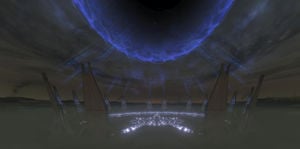
| |
| General overview | |
|
Description: |
Disc with seven pairs of rising petals |
|
Location: |
|
| Operation overview | |
|
Type: |
Slipspace portal generator |
|
Function: |
generation of a portal to Installation 00 |
|
Date of construction: |
began in 97,445 BCE |
|
Status: |
Functional |
| Structural information | |
|
Diameter: |
117 kilometers (73 mi)[1] |
The Portal at Voi,[1][2] known to the scientific community as the Excession at Voi or simply the Excession[3] and sometimes referred to as the Artifact,[4] is a massive Forerunner construction in Kenya, Africa on Earth. It was designed to generate a slipspace portal to Installation 00. It was built across and eventually buried beneath an area that would come to encompass the town of Voi and the city of Mombasa, and it was uncovered by the Covenant during the Battle of Earth in late 2552. It can be activated by a specific keyship, that being the Covenant's "Forerunner Dreadnaught", and was so activated upon its unearthing. It was reactivated once more in March of 2555 with the help of Drifts Randomly, a Huragok that had worked on the Dreadnaught.
History
Ancient history
- "Who will use this portal? Who will live to return here? And what will they think of this machine that I’ve buried? Those I have fought for, for so long. Those who, it is clear to me now, ultimately will and must inherit the Mantle. I can only hope that they will survive and upon returning, that they will find this portal and use it to travel to the Ark—in order that they might discover their rightful place in this galaxy, and the great responsibility they have finally inherited. They are the last of my children. They must reclaim their birthright."
- — The Librarian thinks on the future of the portal and its use by humanity.
Shortly before the firing of the Halo Array, the Forerunner known as the Librarian ordered the construction of the portal beneath a savannah in what would later become Kenya. The Librarian knew that the portal would not be completed before the Halos were fired, and thus construction would continue for at least a century after Earth was reseeded. She had it built with the hope that humanity would one day use it to reap the benefits of the legacy the Forerunners left on the lesser Ark. A Gargantua-class transport sent by 343 Guilty Spark at her request, along with the necessary components mined from the Earth, was used to build the portal.[5] At least two varieties of sentinels, Retrievers and Assemblers, were deployed from the transport and were also important to its construction.
When humans and other lifeforms were reintroduced to Earth, they emerged at the planet above the portal in Africa.[6] However, work on it would continue for multiple generations. Its continual construction was witnessed by humans, including an African elder named N'chala, who was oblivious to its purpose and considered the sentinels to either be gods or to be under their direction.[7] While the artifact was always designed to be partially buried in the earth, it eventually came to be entirely buried through unknown means.
Discovery
- "Truth could've landed anywhere, but he committed all his forces here. East Africa. The ruins of New Mombasa. Then, they started digging."
- — Miranda Keyes informs John-117 of the Covenant's excavation.
By at least the nineteenth century, the portal was originally entirely submerged beneath the land occupied by the city of Mombasa and the town of Voi, lying at least partially underneath a man-made lake. At some after the dawn of the twenty-fourth century, the UNSC's Office of Naval Intelligence discovered a small section of the portal structure located below the metropolis of New Mombasa, and constructed a major facility known as the ONI Alpha Site in the city in order to conduct covert research on the artifact.[8] In 2551, toward the end of the Battle of Meridian, a luminary was discovered by the Covenant on the moon. Ths luminary would later be presented to the Prophet of Regret and reveal to him the location of the portal. In October of 2552, a seismic anomaly originating with the portal was discovered in a survey conducted by New Mombasa's urban infrastructure AI, the Superintendent, for Dr. Endesha, revealing the location and full extent of the structure to him.[9]By November 17, 2552, the entire lake that lay over where it was buried had been vaporized by Covenant ships and the earth overtop of the artifact had been burned away by focused glassing to unveil it.[10]
Following the Prophet of Regret's flight from the Sol system during the Battle of Earth, a massive Covenant fleet led by Jiralhanae arrived to swiftly take control of the battle from the Sangheili. These forces attempted to use the data gathered by the Superintendent to pinpoint the location of the artifact, but were eventually forced to discover its location on their own. On the same day, they started the uncovering of the artifact by glassing. By November 17, 2552, the entire lake that lay over where it was buried had been vaporized by Covenant ships and the earth overtop of the artifact had been burned away by focused glassing to unveil it.[10] The Prophet of Truth landed the Forerunner Dreadnought on the structure, and an unusual electric storm formed above it. Before its activation, the prophet personally traveled to the Superintendent's data center deep underneath where New Mombasa used to be, now occupied by a number of Covenant Huragok, and observed a section of the artifact visible from the facility.[11]
The UNSC attempted to attack the keyship, falsely presuming the portal to be the Ark itself, but was stopped by Covenant Type-27 Anti-Aircraft Cannons. A small force in the city of Voi, consisting of John-117, Thel 'Vadam, Marines, and factory workers from a Traxus Industries facility, neutralized an anti-aircraft battery to clear a path for three frigates and numerous Longswords. These then made several attacks on the Dreadnought with MAC cannons and ASGM-10 missiles, but to no effect. At that moment, the gateway finally activated, opening a large slipspace rift above the Portal which led to the real Ark. Truth and his fleet advanced through the rift and were pursued by the Fleet of Retribution and the UNSC Forward Unto Dawn.
Post-War Period
- "There are more secrets locked under our feet than we dare speculate on."
- — Doctor William Iqbal in a letter from the Department of Xenoarchaeological Studies at Edinburgh University to security-cleared faculty and onsite graduate students.[3]
When Installation 04B was prematurely fired on December 11, 2552, it tore itself to pieces, doing an enormous amount of damage to the Ark. This sudden destruction caused the portal to collapse while the Forward Unto Dawn was still traveling through it back to Earth. The ship was torn in to two large pieces at this time and only the fore half made it back to Earth, crashing into the Indian Ocean. The *Dawn* did not exit at the point in Earth's atmosphere where it would have had the portal remained wholly intact, but instead emerged from slipspace in Earth's orbit, just narrowly allowing Thel 'Vadam a destination to land. From that point onward, the portal remained inert and inaccessible. In 2553, civilian xenoarchaeologists were hired by the Office of Naval Intelligence to study the artifact. While closed, it was still drawing power from an unknown source and the majority of the passageways below it were still unexplored.[3]It was suspected that the portal had additional as-of-yet undiscovered functions besides simply creating a gateway between Earth and the Ark.[3]
In 2555, scientists exploring Installation 07 discovered a countdown sequence and it was determined that it was originating from the Ark. It suddenly became pf paramount importance that the portal be reactivated. The UNSC reached out to the Swords of Sanghelios and a Huragok named Drifts Randomly that had worked onboard the Forerunner Dreadnaught was brought to Earth. After a few days, it was able to open the portal using data from the keyship it had internalized. A joint UNSC and Swords of Sanghelios team was sent through the portal to prevent the activation of the Halo Array. The countdown was part of a ploy by the Ark's monitor, 000 Tragic Solitude, to make the humans on Earth reactivate the portal so that he could send Retriever Sentinels to mine the Sol system for materials to repair damage done to his installation. Many Retrievers poured through the portal and the UNSC Home Fleet engaged them in battle. Operation: FAR STORM successfully prevented Solitude's plan from coming to fruition, however, and the sentinels were recalled.[12]Afterwards, the UNSC used the now-active portal to send researchers to the Ark.
Trivia
- Before Halo: The Essential Visual Guide established a definitive diameter for the portal, there was some confusion regarding its size. This was due to a conflict between the in-game sizes of the Forerunner Dreadnought in Halo 2 and Halo 3, with the latter depicting the ship as being far smaller than its former incarnation. Based on the map geometry in Halo 3, the Portal could be estimated to be approximately 25 kilometers in diameter.[13] However, this figure is contradicted by the geography of the Portal's surroundings; since the structure stretches from the edge of where the metropolis of New Mombasa used to be all the way to the edge of what was formerly Voi, a distance of well over 100 kilometers. The canonical size of the portal can be derived by referencing the in-game measurements of the Forerunner Dreadnought as it appears in Halo 2.[14][15][16][17] The sizes of the portal and the Dreadnaught in Halo 3 were taken as a liberties resulting from to engine limitations; generating map geometry for over a 117 km2 area would have been extremely taxing, if not impossible, for the game engine.
- In the "Behind the Scenes" section of the Halo 2 Collectors Edition, there is a sketch of the portal.
- The fourteen petals of the portal structure may be a reference to the number 7, as 7+7=14. The entire structure also appears to be constructed of seven identical parts, those being seven pairs of petals. The Portal is also 117 kilometers in diameter, which is a direct reference toJohn-117.
- Originally, the structure that ended up being the portal had been intended to be the Ark itself. Interestingly, the UNSC assumed the portal was the Ark as it neared activation in *Halo 3*.
- The petals bear a striking resemblance to the monoliths around the Atmosphere Processor in the film Aliens.
- The portal encountered in the first chapter of Spartan Ops Episode 7 is nearly identical in design to that of the portal at voi; with petals that withdraw downward when the portal is deactivated.
Gallery
Ancient humans viewing the portal in the years after the fulfillment of the Conservation Measure.
Truth's fleet uncovering the Portal.
A portion of the portal structure that was visible underneath the ONI Alpha Site.
- Ark sTITCH.jpg
Concept art for "the Ark", as it was once conceived as, seen in the Halo 2 Collector's Edition DVD.
List of appearances
- Halo 3 (First appearance)
- Halo 3: ODST
- Halo Legends
- Halo: Evolutions - Essential Tales of the Halo Universe
- Human Weakness (Mentioned only)
- From the Office of Dr. William Arthur Iqbal (Mentioned only)
- Halo: Silentium
- Halo: Rebirth
- Halo: Broken Circle (Mentioned only)
- Halo 2: Anniversary
- Halo: New Blood (Mentioned only)
- Halo: Spartan Strike (Mentioned only)
- Halo: Hunters in the Dark
Sources
- ^ Jump up to: a b Halo: The Essential Visual Guide, page 146
- ^ Halo: Evolutions - Essential Tales of the Halo Universe, "Human Weakness", pages 382, 395
- ^ Jump up to: a b c d Halo: Evolutions - Essential Tales of the Halo Universe, From the Office of Dr. William Arthur Iqbal
- ^ G4TV Bungie Interview, December 8, 2009
- ^ Halo: Silentium, String 37
- ^ Halo: Rebirth
- ^ Halo 3: The Cradle of Life
- ^ Halo: The Essential Visual Guide, page 132
- ^ Halo 3: ODST, Sadie's Story
- ^ Jump up to: a b Halo 3, campaign level The Storm
- ^ Halo 3: ODST, Legendary ending cutscene
- ^ Halo: Hunters in the Dark
- ^ halo.bungie.org: Artifact Sizing *Minor H3 Spoilers*
- ^ Halo 2
- ^ Halo 3
- ^ Halo 3: ODST
- ^ Halo.bungie.org: Determining the Real Sizes of Objects in Halo
| ||

